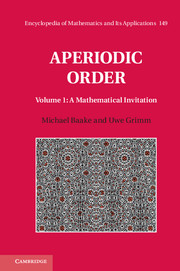Book contents
- Frontmatter
- Contents
- Foreword
- Preface
- Chapter 1 Introduction
- Chapter 2 Preliminaries
- Chapter 3 Lattices and Crystals
- Chapter 4 Symbolic Substitutions and Inflations
- Chapter 5 Patterns and Tilings
- Chapter 6 Inflation Tilings
- Chapter 7 Projection Method and Model Sets
- Chapter 8 Fourier Analysis and Measures
- Chapter 9 Diffraction
- Chapter 10 Beyond Model Sets
- Chapter 11 Random Structures
- Appendix A The Icosahedral Group
- Appendix B The Dynamical Spectrum
- References
- List of Examples
- List of Remarks
- Index
Preface
Published online by Cambridge University Press: 18 December 2014
- Frontmatter
- Contents
- Foreword
- Preface
- Chapter 1 Introduction
- Chapter 2 Preliminaries
- Chapter 3 Lattices and Crystals
- Chapter 4 Symbolic Substitutions and Inflations
- Chapter 5 Patterns and Tilings
- Chapter 6 Inflation Tilings
- Chapter 7 Projection Method and Model Sets
- Chapter 8 Fourier Analysis and Measures
- Chapter 9 Diffraction
- Chapter 10 Beyond Model Sets
- Chapter 11 Random Structures
- Appendix A The Icosahedral Group
- Appendix B The Dynamical Spectrum
- References
- List of Examples
- List of Remarks
- Index
Summary
The theory of aperiodic order is still a relatively young field of mathematics. It has grown rapidly over the past three decades following the experimental discovery of aperiodically ordered materials. This is the introductory volume of a book series that attempts to provide a comprehensive account of the field, which is still developing. We entitled this volume ‘a mathematical invitation’ because we hope that it will inspire readers to enter the fascinating (and largely still to be explored) world of aperiodic order and provide the background that enables them to follow the current developments. Subsequent volumes will address particular as well as complementary topics in more depth, in the form of selected survey articles contributed by expert authors. While the scope and the details of the later volumes are still evolving, the second volume will focus on crystallography and almost periodicity, and the third is planned to expand on model sets and dynamical systems.
It was our aim to keep this introductory volume at a relatively elementary level, and to make the subject accessible to both mathematicians and physicists, which requires a certain compromise for the exposition. Consequently, we ask readers with a mathematical background for their patience for our largely constructive and often example-motivated approach, which sometimes also requires substantial explicit calculations. In particular, we do not strive at a formal exposition at maximal generality, but rather at emphasising the meaning of the formalism at each step.
- Type
- Chapter
- Information
- Aperiodic Order , pp. xv - xviPublisher: Cambridge University PressPrint publication year: 2013

